Free shipping for all orders over 30 euros!
-
Shop
- Insights
-
About ROMBO
- Dealers
- Guitar Pick finder
- Gift Card
+Categories
- accessories
- bass
- bass pick
- bass picks
- bass plectrum
- bass plectrums
- beginner
- bright tone
- chose guitar pick
- chose guitar picks
- chose plectrum
- chose plectrums
- CrystalBright
- Diamond
- Diamond pick
- discipline and guitar
- DIY generation
- durability pick
- durable pick
- eco
- ecoblack
- find guitar pick
- find plectrum
- fingers vs picks
- grip
- grip guitar pick
- guitar accessories
- guitar advantages
- guitar benefits
- guitar career
- guitar health
- guitar injury
- guitar learn
- guitar lesions
- guitar lesson
- guitar method
- guitar noise
- Guitar noise plectrum
- guitar pain
- guitar pick
- guitar pick beginner
- guitar pick bevel
- guitar pick buy
- Guitar pick diamond
- guitar pick durability
- guitar pick durable
- guitar pick eco
- guitar pick features
- guitar pick grip
- guitar pick material
- Guitar Pick Noise
- Guitar Pick online
- guitar pick recycled
- guitar pick recycled material
- guitar pick special features
- guitar pick textures
- guitar pick thickness
- guitar pick variable thickness
- guitar picks
- guitar tone
- guitar warm-up
- guitarpick
- guitarpicks
- hold a guitar pick
- hold guitar pick
- hold guitar picks
- hold pick
- hold plectrum
- hold plectrums
- how to
- how to chose your guitar picks
- jazziii
- learn guitar
- lose guitar pick
- material
- materials
- mental health and guitar
- motivation and guitar
- music
- not to lose guitar pick
- Online guitar
- online guitar pick
- online guitar pick buy
- pick
- pick durability
- pick material
- pick noise
- Picks
- picks vs. fingers
- play bass fingers
- play bass picks
- play bass with fingers
- play bass with pick
- play bass with picks
- play bass with plectrum
- play guitar faster
- plectrum
- plectrum attributes
- plectrum beginner
- plectrum bevel
- plectrum characteristics
- plectrum features
- plectrum grip
- plectrum material
- plectrum noise
- plectrum recycled
- plectrum shape
- plectrum variable thickness
- plectrums
- Plek
- pua
- recycled
- recycled guita pick material
- recycled guitar picks
- recycled picks
- recycled plectrum
- Rombo Diamond
- rombopicks
- tendonitis guitar
- the guitar pick
- tone
- variable thickness
- warm tone
- warm-up guitar

The Benefits of Playing Guitar: A Comprehensive Guide to Enriching Your Life
Playing the guitar is more than just a hobby or a way to pass the time; it’s a powerful tool that can transform your life in myriad ways. From boosting your mental health to enhancing your social skills, playing the guitar offers a wide range of benefits that extend far beyond the music itself. Whether you’re a beginner picking up the guitar for the first time or an experienced player looking to deepen your understanding of its impact, this article will explore the many advantages of playing the guitar.
1. Learn to Focus for Long Periods of Time
In today’s fast-paced, technology-driven society, the ability to focus has become a rare and valuable skill. The constant barrage of notifications, emails, and social media updates can make it difficult to concentrate on a single task for an extended period. However, playing the guitar can help you develop the skill of deep focus, allowing you to shut out distractions and immerse yourself in the music.

When you focus on learning a piece of music, you engage in deep work—a state of heightened concentration where your brain is fully committed to the task at hand. This level of focus not only improves your guitar playing but also builds mental resilience. Over time, this ability to concentrate intensely will carry over into other areas of your life, making it easier to handle challenging tasks at work or during moments of high stress. With improved mental endurance, you’ll find that you’re less fatigued at the end of the day and able to learn new skills more quickly.
2. Guitar and Self-Discipline
Self-discipline is a crucial component of success in any endeavor, and playing the guitar is no exception. While natural talent can give you a head start, consistent practice and dedication are what truly allow you to excel. The process of learning to play the guitar teaches you the value of hard work and perseverance.

Developing self-discipline through guitar practice involves setting aside dedicated time each day to practice, turning off distractions like your phone, and pushing through challenges even when you’re tempted to give up. By committing to a regular practice routine, you’ll develop a strong work ethic that can be applied to other areas of your life, whether it’s your career, education, or personal goals. Some say that self-discipline is the key to happiness, and the guitar can be a powerful tool in helping you cultivate this essential life skill.
3. Enter the State of Flow More Easily
The “state of flow” is a psychological concept that refers to a mental state in which a person is fully immersed in an activity, losing all sense of time and self-awareness. This state is often described as the optimal experience, where creativity and productivity are at their peak. Playing the guitar is an excellent way to achieve this state of flow, especially as you become more proficient.

With enough practice, you’ll develop warm-up routines and techniques that help you enter the state of flow more easily. Whether you’re improvising a solo, writing a new song, or simply practicing scales, the guitar can transport you into a world where time seems to stand still, and your creativity flows effortlessly. This ability to enter the state of flow can be incredibly beneficial in other areas of your life, such as when you’re working on creative projects, solving complex problems, or engaging in any activity that requires deep focus.
4. Playing Guitar Gives You a Confidence Boost
Playing the guitar is inherently cool, and the sense of accomplishment that comes with mastering a challenging piece or performing in front of others can provide a significant confidence boost. The combination of overcoming obstacles, setting and achieving goals, and expressing yourself through music all contribute to a heightened sense of self-confidence.

This confidence isn’t just limited to your guitar playing—it can spill over into other areas of your life. Whether it’s giving a presentation at work, meeting new people, or taking on new challenges, the confidence you gain from playing the guitar can help you approach life with a more positive and self-assured attitude.
5. Improve Your Motor Skills
Playing the guitar requires the coordination of multiple motor skills, including hand-eye coordination, finger dexterity, and rhythmic timing. To play a piece of music correctly, you must coordinate your picking hand, fretting hand, and even your breathing and posture. If any one of these elements is out of sync, the quality of your performance will suffer.

Regular guitar practice helps improve your motor skills, making it easier to perform complex tasks that require fine motor control. These enhanced motor skills aren’t just beneficial for playing the guitar—they can also make it easier to learn other instruments or skills that require precise hand movements. For example, if you decide to pick up the bass, ukulele or mandolin after learning the guitar, you’ll likely find that you can master these instruments more quickly due to your improved motor skills.
6. Guitar Playing Keeps You Motivated
Motivation is a key factor in learning and personal growth, and playing the guitar can be a powerful motivator. The process of learning new songs, mastering challenging techniques, and setting and achieving goals keeps you engaged and motivated to continue improving.

One of the most rewarding aspects of playing the guitar is the sense of accomplishment you feel when you finally nail a difficult riff or play a song flawlessly from start to finish. This sense of achievement can keep you motivated to practice regularly and push through the challenges that come with learning any new skill. The motivation you gain from playing the guitar can also carry over into other areas of your life, helping you stay focused and committed to achieving your personal and professional goals.
7. Learn Multitasking
Playing the guitar requires you to multitask in several ways. You need to read sheet music or tablature, keep time with your foot or a metronome, control your breathing, and coordinate your fingers—all at the same time. This simultaneous engagement of multiple cognitive and physical tasks helps improve your multitasking abilities.
Improving your multitasking skills through guitar playing can have a positive impact on your daily life. Whether you’re juggling multiple projects at work, managing household tasks, or balancing your social life with personal responsibilities, the ability to multitask effectively is an invaluable skill that can help you stay organized and efficient.
8. Social Benefits: Meet Like-Minded People
Playing the guitar is not only a solitary pursuit but also a social activity that can connect you with like-minded individuals. Whether you join a band, participate in a jam session, or take part in online guitar communities, playing the guitar can help you build a network of fellow musicians and music enthusiasts.

These social connections can lead to valuable friendships, mentorship opportunities, and even professional collaborations. By surrounding yourself with others who share your passion for music, you’ll find inspiration, support, and encouragement to continue growing as a guitarist and musician.
9. Reduce Stress
In today’s hectic world, finding effective ways to reduce stress is more important than ever. Playing the guitar offers a healthy and enjoyable way to unwind and relieve stress. The act of playing music has been shown to lower cortisol levels—the hormone responsible for stress—while increasing the production of dopamine, a neurotransmitter associated with feelings of pleasure and reward.
When you play the guitar, you enter a state of mindfulness, where your attention is fully focused on the music. This mindfulness can help you temporarily escape from the pressures of daily life, allowing you to relax and recharge. Whether you’re strumming your favorite chords, improvising a solo, or simply practicing scales, playing the guitar can be a powerful tool for managing stress and maintaining your mental well-being.
10. Boost Your Creativity
Playing the guitar is a highly creative activity that encourages you to think outside the box and explore new musical ideas. Whether you’re composing your own songs, experimenting with different chord progressions, or improvising solos, the guitar provides endless opportunities for creative expression.

Regularly engaging in creative activities like playing the guitar can enhance your problem-solving skills, improve your ability to think critically, and foster innovation in other areas of your life. Whether you’re a musician, artist, writer, or entrepreneur, the creativity you cultivate through playing the guitar can help you approach challenges with a fresh perspective and develop unique solutions.
11. Keep Your Brain Active, Especially in Old Age
As we age, it’s important to keep our brains active and engaged to maintain cognitive function and prevent mental decline. Playing the guitar is an excellent way to keep your brain sharp, as it requires you to continuously learn new skills, memorize songs, and coordinate complex movements.

Studies have shown that playing a musical instrument can improve memory, increase neural connectivity, and even delay the onset of dementia. Whether you’re a young adult or a senior citizen, playing the guitar can help you keep your mind active and healthy, providing long-term cognitive benefits.
12. Express Your Feelings Through Music
Music is a universal language that allows us to express our emotions in ways that words cannot. Playing the guitar gives you a powerful outlet for expressing your feelings, whether it’s joy, sadness, anger, or love. Through your guitar playing, you can convey emotions that might be difficult to articulate verbally, creating a deep and personal connection with the music.

This emotional expression can be incredibly therapeutic, helping you process and release pent-up feelings. Whether you’re writing your own songs or playing covers of your favorite artists, the guitar provides a medium for expressing your innermost thoughts and emotions.
13. Feel Part of Something Bigger
Playing the guitar connects you to a rich musical tradition that spans cultures, genres, and generations. Whether you’re playing classical guitar, blues, rock, or jazz, you’re participating in a global community of musicians who share a passion for creating and performing music. This sense of belonging can be incredibly fulfilling, as it allows you to contribute to a larger cultural narrative and be part of something bigger than yourself.

Additionally, playing the guitar can connect you with others who share your musical interests, whether it’s through jam sessions, concerts, or online communities. This sense of connection and shared purpose can be a powerful motivator, encouraging you to continue learning and growing as a guitarist.
14. Personal Satisfaction: Achieving Goals
One of the most rewarding aspects of playing the guitar is the sense of personal satisfaction that comes from setting and achieving goals. Whether it’s mastering a difficult song, learning a new technique, or performing in front of an audience, the guitar provides countless opportunities for personal achievement.

This sense of accomplishment can boost your self-esteem and motivate you to set and pursue new goals, both in your guitar playing and in other areas of your life. The discipline, focus, and perseverance you develop through playing the guitar can help you achieve success in whatever you set your mind to.
15. Take You Out of Your Comfort Zone
Learning to play the guitar can be challenging, especially when you’re first starting out. However, stepping out of your comfort zone and pushing through these challenges is where real growth happens. Whether it’s performing in front of others, learning a new genre of music, or tackling a difficult technique, the guitar constantly challenges you to expand your skills and push your boundaries.

By embracing these challenges, you’ll develop a greater sense of resilience and adaptability, which can help you face challenges in other areas of your life with confidence and determination.
Conclusion
Playing the guitar offers a wealth of benefits that extend far beyond the music itself. From improving your mental focus and motor skills to boosting your confidence and creativity, the guitar is a powerful tool for personal growth and self-expression. Whether you’re a beginner or an experienced player, the journey of learning to play the guitar can enrich your life in countless ways, helping you become a more focused, disciplined, and fulfilled individual.
So, pick up your guitar and start playing—you never know just how much it might change your life for the better.
__________


8 Myths about guitar picks
8 Myths about guitar picks
We have been in the guitar pick industry for a couple of years now. During this time, numerous customers have sent lots of inquiries with repeated questions and myths.
We have summarized the top 8 myths that “shocked” us the most, and we explain why they don’t make any sense!

1st Myth: Guitar picks don't influence guitar tone.
In guitar picks, qualities like thickness, material, shape, and size play a pivotal role in tone, feedback, grip, guitar pick noise, sustain, etc…
Why this happens has a simple explanation: Different shapes or materials make the guitar strings vibrate in different patterns.
In our article “Do guitar picks really affect the tone of your guitar” we discuss all the aspects in detail.
2nd Myth: There is a "best" pick for everything
The guitar is one of the most popular instruments because it is versatile. This versatility is achieved by a broad range of techniques. Different techniques require different picks.
Like in every guitar aspect, there is no "better" or "worse".
If you are looking for a brighter sound, then Tortex might be your choice. Nevertheless, if your aim is to get a warmer/darker/deeper tone, other materials like Nylon could perform way better.
The same applies to guitar pick thickness, shape, size, the grip texture, etc.
I recommend having at least 3 to 5 guitar picks for different specific usages. If you do not know where to start you have three options:
- Learn about guitar picks
- A Variety Pack
- Get advice (free advice here)

3rd Myth: You don't need picks if you know how to play with your fingers
Both methods are valid and appropriate for the right musical context. Your goal as a musician is to be able to create the sounds you imagine. The method is up to you!
However, some basic techniques like tremolo picking, palm mute, pinch harmonics, or pick slides are very difficult to perform with fingers. Even more, they are also faster to learn if you use guitar picks. This point also plays a role in keeping your motivation at a high level.
If you love both picking methods you’ll end up with a broader technique repertoire and will profit from both worlds.
4th Myth: Bryan May uses a coin. Everyone should do the same.
You can make a pick out of every item, a penny, paper, old credit cards, or anything else. The important thing here is the joy of exploration. Not the specific taste of one excellent influential guitarist.
Imagine how much you’ll limit yourself if you make the wrong decisions at the beginning of your career.

5th Myth: Guitar picks don't have an influence on speed.
Some qualities like pick shape, a beveled edge, and a polished guitar pick can play an important role in your speed.
“Real” guitar shredders use thick and pointy guitar picks. Probably this combination is the best place to start if you are looking for guitar speed. But remember, the most influential factor when it comes to developing speed is the number of hours of deliberate training!

6th Myth: Once you find a pick that works for you, stick to it forever.
If every song has different requirements, why always use the same guitar pick?
Different guitar picks make a difference in your tone and your playing.
I am not saying that’s impossible to play a “master of puppets” with a 0.38 mm rounded guitar pick. It is all a matter of practice and habits. However, with the right tools, you will learn faster.
In this case, for such a song with lots of palm-mute and downpicking, I would choose a thick, pointy, durable guitar pick, like Rombo Diamond.

If later today, I’m feeling like playing bossanova-jazz phrases with my semi-hollow guitar, I’ll probably use a rounded medium pick. Preferably our of Nylon.
7th Myth: Guitar picks are expensive
This is one of the most controversial aspects related to guitar picks.
You can find arguments for both the “cheap” and the “expensive” side.
Argument: “Guitar picks are expensive”:
- It’s just a piece of plastic
- I’ll lose it very fast
Argument: “Guitar picks are actually cheap”
- If it is a good one, I can use it for over 200 hours (more on durability here)
- It’s the fastest way to change the tone of your guitar
- It’s the bridge between your hands and your instrument and it deserves more attention.
- It costs less than a cup of coffee.
Put in perspective, when you purchase a guitar pick you don’t only “buy a piece of plastic”. Behind the shape and the material development there is a lot of engineering going on.
In addition, you are supporting the infrastructure behind it (customer support, web development, logistics, production, marketing, distribution, R&D, packaging,...). Without one of these single elements, there won’t be guitar picks.
8th Myth: After five seconds on the floor, a pick disappears and goes to an unknown dimension.
This happens after only three seconds, not five.

Common Guitar-related Injuries and how to Avoid Pain when Playing the Guitar

Playing the guitar is fun and requires numerous hours of practice. Sometimes guitarists find themselves developing pain in different parts of the body such as their wrists, back, neck, forearm, and/or fingers.
Guitarists underestimate the dangers of injuries. According to the Bureau of Labor and Statistics, in recent surveys, nearly three-fourths of professional musicians reported past injuries and pain that affected their playing.
Every guitarist I know underestimates the risks and frequency of injuries caused by playing an instrument. As with many repetitive activities (like sports), you can prevent some injuries by understanding the root cause. Being aware of this is the only way you can commit to your guitar practice and have a worry-free (and pain-free) guitar-playing routine.
In this article, we will cover the following topics:
- Reasons for injuries caused by guitar playing
- Common guitar injuries and symptoms
- How to avoid injuries and pain when playing the guitar
Disclaimer: This article is not medical advice and is not a replacement for diagnosis or treatment by a qualified medical professional. Our goal is to advise you of some preventive methods to help you avoid injuries in the first place.
1- Reasons for injuries caused by playing the guitar
Playing the guitar, there are many sources of injuries that can be overlooked.
In most cases, the pain caused by playing the guitar starts from a combination of some of these reasons:
- Practice time
- Bad posture
- Too much pressure on the fretboard
- Bad finger technique
- Lack of a warm-up routine#
- Avoiding breaks and fatigue
- Weight of your guitar
- Prior non-guitar-related injury aggravated by playing the guitar
- Genetics (like genetic chronic back pain that can be promoted by playing the guitar)
In chapter 3, we will discuss how to prevent injuries and pain caused by guitar playing and will explain some “best practices” related to these reasons.
2- Common Guitar Injuries and Symptoms
Guitar injuries are serious because they can take guitar players out of the game permanently. There are many examples of these tragedies along with the history of music and their reason is always the same—underestimating the signals that your body sends to you.

If you are experiencing pain in some of the following areas, your body is trying to tell you that something is wrong. In that case, going to the doctor is the best option. If you want to learn how to prevent these injuries, go to chapter 3.
Most injuries can be categorized as RSI or Repetitive Strain Injury. RSIs are often long-term injuries that won't go away easily. These are directly associated with specific activities that involve repetitive movements. Guitar learning is all about repetition.
If you are experiencing pain in any of the following areas, our recommendation is to take a break for a few days and visit the doctor to ensure things aren’t more serious than they seem on the surface.
2.1- Pain in the forearm when playing the guitar:
Unlike what many guitarists think, forearm injuries are not only common for the fretting hand but also for the strumming one. If your hand position is tight, your forearm muscles are likely to tighten up too.

Putting too much pressure on the fretboard or holding the guitar pick with too much tension can develop into tendonitis.
Tendonitis is the inflammation of the tendons—the tissue that connects muscles and bones together and is involved in the function of moving your body properly.
Symptoms are pain, swelling, and motoric problems like limited hand movements. Many guitarists describe it as “the forearm feels like an old rubber band".
2.2- Pain in the hand area when playing the guitar. Wrists and fingers:
We are not talking about fingertips pulp pain known by every beginner guitar player without calluses. Those develop over time, making guitar playing comfortable at some point.
The main issue in these areas is Carpal Tunnel Syndrome that not only affects guitar players, but also any kind of activity that involves fast, precise, and repetitive finger and hand movements like pianists, hairstylists, video gamers, etc.

Again, the tendons are involved as in many movement injuries. The flexor tendons that go from the fingertips to the forearm can be easily stressed.
Symptoms are pain, weakness, or motoric problems like limited hand movements.
2.3- Pain in the elbow when playing guitar:
The famous "tennis elbow" is also a guitarist's nightmare. Technically, this is also an issue that concerns the tendons, and its correct name is "lateral epicondylitis."
The main symptoms are pain when gripping the fretboard or pain on the outside edge of the elbow.
As in most problems related to the tendons, the first symptoms are very subtle, and this can be ignored by ambitious guitar players who want to add some extra practice to their daily routines. If you are starting to feel this, the best way to prevent it is to have a rest for a couple of days and visit the doctor if the pain persists.
2.4- Pain in the back and shoulders when playing the guitar:
A lot has been said about posture, and this has a simple reason. Good posture habits can save you from experiencing lots of pain.
The problem with playing the guitar is that you need to position yourself in a bad posture to actually see what your fretting hand is doing properly. When you focus on the movements of your hands, it is very easy to forget what the rest of your body is doing, and you might slouch or sit with your back curved with no tension on it.
Back pain is dangerous because everything here is connected. So symptoms can appear on the shoulders, lower back, upper back, neck, and in other areas. This depends on many individual factors.
Fact is, this can be prevented by practicing good posture and holding the guitar closer to you as we will discuss in chapter 3.
This problem is very common among ambitious beginners that want to scale their skills fast.
A combination of three things causes the pain:
- Looking to your left for hours (or right if you are left-handed). As a beginner, you cannot practice without looking at your fretting hand.
- Fatigue of the neck muscles is caused by a lack of endurance. You are a beginner, so you did not have enough time to adapt to this new environment and movement ranges.
- Last but not least, lack of experience to estimate the reactions your skeleton and muscles might have.

3- How to avoid Injuries and Pain when playing the Guitar:
On an Instagram survey we performed with 455 participants, 64% reported having had some injuries in the past. This means almost two-thirds of the guitarists that participated have experienced some pain or lesions. You are lucky if you are amongst the 36% injury-free guitar players.

Simple actions can make a huge difference in your playing and help you avoid injuries and pain when playing the guitar:
3.1- Warm up before playing the guitar:
Playing at even semi-intense levels is stressful on the arms, hands, and the back and shoulders, just like a gym workout would be. So you need to treat it as a sport.
Warm-up can be something as easy as stretching your fingers or starting off your session by playing some techniques that aren’t as demanding as your current guitar level.

The cool thing about warming up is that once you start playing, your muscles are already prepared to deliver their best performance.
We have summarized our seven favorite warm-ups HERE.
3.2- Proper guitar technique, posture, and guitar position:
I am a big fan of self-learning. I have used self-learning techniques for foreign languages, technical skills, software, and cooking. However, in guitar, and especially in terms of avoiding injuries, I cannot repeat it enough: get a teacher.
A professional experienced teacher can help you not only develop your skills and define your learning path but also avoid and correct bad posture, too much finger tension, wrong guitar position, and other bad habits such as slouching when playing the guitar.

My recommendation if you do not have a teacher:
- Go for 2-3 private lessons that only focus on posture, technique, and guitar position
- Practice as per the advice of the teacher in front of a mirror
Sure, it will cost you some extra money, but it will prevent future problems that have a higher impact on your life than a couple of bucks.
3.3- Play guitar with less tension:
Typical tension areas are the forearms, fingers, and back.
What I did to avoid this is playing simple chords and phrases that I knew well and, while playing, concentrating on other areas of my body: is my back straight? Am I placing too much tension on the fretboard? Am I holding my guitar pick correctly? Can I avoid turning my neck and looking left?
Some hand tension can be avoided by holding the guitar pick properly. If are experiencing this, you can check our article How to hold a guitar pick.
3.4- Breaks and time management when playing the guitar:
There is a rule of thumb amongst experienced guitar players; 50 minutes practice, 10 minutes rest.
In the 10 minutes, you can check harmony and music theory, study some tabs or just stand up and move around to reduce your overall body tension.
This has two advantages:
- It prevents injuries by giving your body a break, and
- You will feel fresh after the break which results in higher quality practice results.
3.5- Do not play the guitar through pain:
If you experience some sort of pain while playing the guitar, this isn’t normal. Stop playing immediately and take a break, then evaluate whether you should go to the doctor or the physiotherapist.
3.6- Play sport:
Having good musculature in other areas of the body helps a lot when playing guitar:
- Muscles with more endurance resist more stress.
- Muscles that are used to exercise recover faster and fatigue slower.
- Regular sport lowers stress levels and diminishes accumulated tensions.
The combination of these aspects make playing sports a great alliance when it comes to guitar playing.
3.7- Use a lighter guitar for practice if you play standing up:
This is only logical: the less weight you put on your shoulders, the less stress you will have to handle. Some professional guitarists use light guitars for practice or even guitar stands and only use their performance guitars for their performances.
This is especially useful for guitar teachers that usually spend their whole days with a guitar in their hands.
3.8- Massages and ice for guitar pain relief:
If you treat guitar playing like a sport—and with sport, I mean high-stress levels caused by muscular movements in some areas of the human body—then you need a cool down.

Massaging your forearms and hands or using ice and cold water to reduce possible swelling can be a very simple additional routine to include in your daily practice. Furthermore, it is proven that such techniques reduce the recovery time, resulting in better practice results the next day.
This can also give your skin a break. If you are dealing with sweat problems when playing guitar I recommend you the article: 10 ways to avoid sweaty hands when playing guitar.
4- Conclusion:
Nearly three-fourths of professional musicians reported past injuries and pain that affected their playing.
Some of this pain disappears after a few days of rest. However, some injuries caused by guitar playing can be very harmful and in the worst case, they will kill your guitar career.
There are simple actions that can prevent you from injuries, such as warm-ups, good posture, breaks and other common-sense actions. The good thing is that these actions are simple and do not take much time. Even better, these actions increase your learning speed.
My advice: Reflect on your routine and consider every chapter of this article as a checklist for avoiding a guitar tragedy. Good luck!
PS: If you are a beginner and need help choosing the right guitar pick, please check our section Guitar Pick Finder or our Guitar Pick Variety Pack.

7 Essential Guitar Pick Techniques
One of the most valuable skills when it comes to guitar playing is versatility.
Versatility allows you to adapt to different environments and enriches your playing, making a difference in the final result.
Music is about staying dynamic and monotony kills dynamic. Therefore, the most logical step for you as a guitarist is to expand your repertoire of guitar skills to keep that vital, engaging sound that makes music so joyful.
If you have decided to use a guitar pick for playing guitar, there are seven techniques that are a must.
They will take time to learn and master, but believe me, they make the difference.

1- TREMOLO PICKING:
If you have listened to the music of the last 70 years, you can probably recognize this guitar technique in most rock classic hits.
Tremolo is an Italian word which means “to shake” or “to tremble”.
In the context of guitar, it involves striking one (sometimes more than one) guitar string very fast with alternating strokes. Therefore, this technique is a form of alternate picking. Tremolo picking is very easy to learn but it requires strong discipline and practice to master.
Tremolo picking is essentially useful for any style of music and obviously a big part of the surf guitar sound (I’m a big fan of it!).

In guitar literature, sometimes the words tremolo and vibrato are reversed. This technique has nothing to do with a “tremolo bar” or a "tremolo effects box".
WHY IS TREMOLO PICKING IMPORTANT?
If one of your long-term goals in your guitar learning process is to increase speed, tremolo picking is a good place to start.
It is not only very fun but also can add new textures and some dynamics to your compositions. You would be surprised how well this technique fits even in metal or hardcore music.
A FAMOUS SONG WITH TREMOLO PICKING:
The surf rock version of the song “Misirlou”, from Dick Dale, is probably the greatest example of tremolo picking. The original one is a traditional song from the Eastern Mediterranean area dating back to 1927!
The version of Dick Dale got very popular after appearing in the soundtrack of Pulp Fiction in 1994.
BEST PICK FOR TREMOLO PICKING:
The most influential factors when choosing the best guitar pick for tremolo picking are thickness, material, and grip.
It’s important to have a snappy, responsive guitar pick. For this, medium picks with a medium/pointy tip are my recommendation.
However, there is no consensus in the guitar world for this. Many players have reported preferring thick, rigid picks.
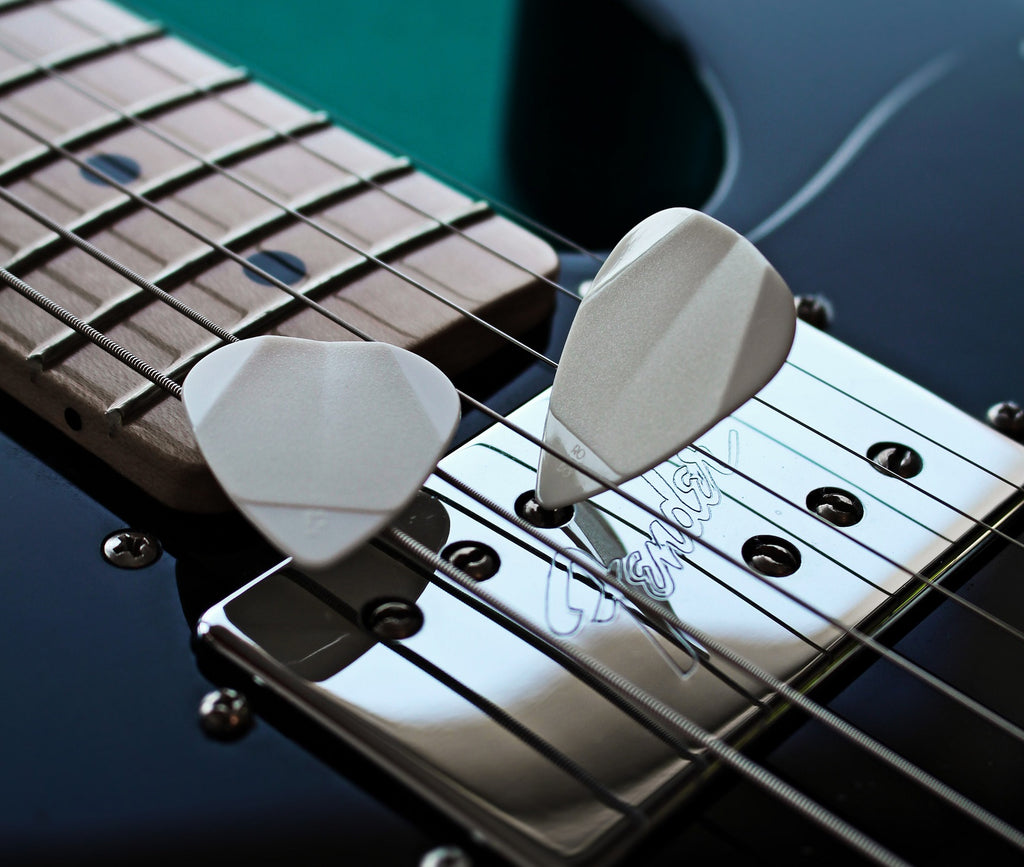
In my case, I have found the best stability and speed using Rombo Origami. This pick can be described as: Flexible but still rigid enough for note control. Right amount of flexibility for a snappy fluid attack that's bright and crisp. The concave surface on the hold area ensures an ergonomic and comfortable hold.
Everyone’s hand is a little different in how they hold the pick and move. The best way to find out is to test different shapes and thicknesses, and then try them out
Good luck!
2- PICK SLIDES:
One very extended technique often performed in the rock, metal, and punk genres is pick slides or pick scrapes.
By holding the edge of the guitar pick against the guitar strings and moving it along the edge, the pick catches the strings’ windings, causing the strings to vibrate and produce a very pleasant textured noise.
Usually, guitar pick slides start near the bridge and end over the higher frets. However, there are countless variations of pick slides depending on the direction, the angle of the pick relative to the strings, and other variables.

Unfortunately, performing pick slides completely ruins the edges of the guitar pick, especially on thinner ones. This won’t directly affect the tone or control of the plectrum, but the damaged sides will develop some dents.
What makes a guitar pick durable? Find our here.
WHY ARE PICK SLIDES IMPORTANT?
Guitar pick slides are not the most relevant aspect of your playing. Nevertheless, a correctly performed slide in the right place will add so much to the moment.

The noisy textures produced by this technique are the perfect weapon of choice for songs using high distortion levels.
A FAMOUS SONG WITH PICK SLIDES:
The first use of the pick slide is attributed to Bo Diddley and can be heard in the opening of his song "Road Runner" from the 60s.
Today, some guitarists have taken this technique to a new level and have created signature variations. A shining example of pick slides from the last years is the metal band Gojira with their famous signature “Gojira-Scrape” that was created by accident and combines several guitar pick techniques
BEST PICK FOR PICK SLIDES:
If you are going to do pick slides frequently, then you need to consider two things:
- Using durable guitar pick materials, and
- Using thick picks.
Otherwise, your guitar picks will be inoperative after a couple of sessions. The dilemma is that most players get better noisy sounds with a medium guitar pick.

I have found a solution that works for me: medium-heavy picks that are large enough to scrape with higher areas of the pick that won’t touch the strings. From our picks, I prefer Rombo Horizon the most for pick slides. Also, the curvy edge creates different pressure on different strings and that’s nice.
3- PINCH HARMONICS:
Do you know any guitar player who does not like pinch harmonics? I do not either.
Pinch harmonics are created by the picking hand. Playing this technique produces high-pitched tones. This phenomenon occurs when you stop a part of the string vibrations in the right position and create a "node".

There is a simple way to test this; pick a note and apply a small pressure anywhere on the string such that the vibration doesn’t stop completely.
WHY ARE PINCH HARMONICS IMPORTANT?
Pinch harmonics are often related to high gain tones and metal music but they are a powerful tool to add dynamics and textures to any genre of music or type of guitar; electric or acoustic.
It is considered one of the most abstruse techniques for intermediate players. Common problems are pinch harmonics that aren't loud enough or additional noises that make the harmonics not sound clean enough.

Root causes of this problem can be:
-
the guitar player does not know the right places on the strings to play pinch harmonics
-
there is unwanted noise coming from unmuted strings
-
the pinch harmonic is produced isolated, without combining it with other techniques like vibrato.
Most guitar players (including me) played their first pinch harmonic accidentally.
A FAMOUS SONG WITH PINCH HARMONICS:
Guitarist Billy Gibbons from ZZ Top is considered the father of pinch harmonics. Not because he invented them, but because he brought them to the mainstream. Although he is a well-rounded guitarist with a focused skillset based on blues, he is best known for his pinch harmonics.
BEST PICK FOR PINCH HARMONICS:
There is no special pick to do pinch harmonics. The pinch harmonic is technically produced by the thumb of your picking hand.
However, this technique is widely used in lead guitar in combination with other advanced techniques that work especially well with thick, small guitar picks.
Therefore, although you can learn pinch harmonics using thin picks, I recommend using thick picks.
 #If you want to learn more about the differences between thin and thick guitar picks read our article "Thick guitar picks vs thin guitar picks".
#If you want to learn more about the differences between thin and thick guitar picks read our article "Thick guitar picks vs thin guitar picks".
4- PALM MUTE:
Palm mute is a very regular technique used by most guitarists. By placing the side of the picking hand on the strings close to the bridge and dampening the guitar strings (when necessary), the strings produce muted sounds.
You can control the dampening effect by moving your hand to a different position further from the bridge.

Although this technique isn't seen as a very difficult one, these are common mistakes that prevent players from learning it properly:
- wrong hand position
- not having a relaxed posture
- problems by keeping a stable tempo
- too much pressure on the strings
WHY IS PALM MUTE IMPORTANT?
As a guitarist or bassist, you are always on the lookout to make your music sound natural, creative, and exciting.
Palm-muting is a great skill for dynamic control exercises. This means you will automatically learn how to shape your sound using fluctuations in volume and intensity.
With this skill in your repertoire, your music will sound more vocal and dynamic.
A FAMOUS SONG WITH PALM MUTE:
This technique is very old. As old as the invention of the electric guitar (1936). Most classical players have been using it for centuries with all kinds of instruments.
Today, palm muting is widely used in heavy metal, thrash, speed, and death metal. It is often found in music that features distortion effects.
Is there any good song to practice palm muting for getting better at it? “Master of Puppets” from Metallica—it’s a masterclass in palm muting and down picking.
BEST PICK FOR PALM MUTE:
I recommend using a thick guitar pick for this. They provide high volume, a broader dynamic range, and more control over single notes (in case you use palm mute arpeggios). In addition, palm muting is a demanding technique that causes a lot of guitar pick wear. As you might know, thick guitar picks are more durable.

My favorite choice for this technique is Rombo Diamond.
5- PICK STRUMMING:
Guitar pick strumming is a way of playing guitar. A strum is a sweeping action where a pick (or finger!) brushes over the guitar strings and generates sounds.
For most guitar players, this is the first technique they learned and the technique that caused most headaches as a beginner.

Learning how to strum correctly takes time and practice. Most beginners lack the necessary muscle memory it takes to play while remaining relaxed or having a good posture.
WHY IS PICK STRUMMING IMPORTANT?
In many ways, understanding this skill is essential for understanding guitar. Great strumming skills mean being a great rhythm guitarist. Therefore, this should be your number one goal as a beginner.
Learning chords is important, but they are just static shapes. The diversity of the hundreds (if not thousands) of strumming patterns available will inject musicality and rhythm into your playing.
A FAMOUS SONG WITH PICK STRUMMING:
“Bad moon rising” by Creedence Clearwater Revival, is a good place to start. It combines easy chords (D, A, G) with a very simple progression and a very catchy, bluesy melody.
BEST PICK FOR STRUMMING:
My best advice for beginners is to start with a very thin guitar pick. It can help to practice with something below 0.6 that’s nice and bendy. As you improve your skills, you can try with thicker picks, as they will add more bass to your tone.

For all the beginners out there, my best choice would be Rombo Classic.
However, if you are in the very beginning of your guitar journey, please read this article where I explain, why starting with medium guitar picks can be a better choice for you. "Medium Gauge Guitar Picks".
6- DOWNPICKING
Downpicking or down-stroke picking is a very beloved guitar technique in which the player moves the guitar pick only in a downward motion. The tip of the pick does not brush the strings as the hand moves back to the original position for the next down-stroke.
It is one of the most underrated skills on guitar and although performing this technique might seem easy, the required endurance for long passages with fast tempo is very often a problem even for advanced guitarists.

WHY IS DOWNPICKING IMPORTANT?
But first, why would you want to remove the upstrokes (alternate picking) and then increase the necessary effort for the same number of strokes? Why would you torture your wrist muscles in this way?
This technique is widely used in metal and punk guitar and the main reason is that when mastered, downpicking can make the guitar’s sound very powerful and rhythmic.
A FAMOUS SONG WITH DOWNPICKING:
Famous punk guitarist Johnny Ramone used this technique in the mid-70s in combination with fast tempo (180 to 200 bpm). The technique was very innovative at that time and influenced many current guitarists like James Hetfield who has been regarded as “the King of Downpicking”.
Many beginner guitarists start with songs from Ramones because of their simplicity in terms of chords and lack of tempo variations.
BEST PICK FOR DOWNPICKING:
For downpicking, there is a basic rule: the more mass the guitar pick has, the thicker and more aggressive the sound.

Therefore, a thick, large guitar pick with a pointy tip will be the loudest and most rhythmic one.
I recommend Rombo Diamond.
7- HYBRID PICKING
The interesting thing about hybrid picking is the fact that the player uses a plectrum as well as one or more fingers. This can be done alternately or simultaneously.
Typical styles for this technique are rockabilly guitar, country and bluegrass, and more classical passages with acoustic or classical guitar.
Hybrid picking can be very hard if you are a beginner. Before you think of learning this technique, you will have to learn how to play with your fingers and with a guitar pick. This is a requirement you cannot avoid.

WHY IS HYBRID PICKING IMPORTANT:
Three major arguments should convince you to learn hybrid picking:
Tone diversity:
The pick is generally used to play bass notes with a longer duration and very noticeable timbral differences caused by variations in the vibration of the strings. Therefore, your playing will sound more interesting combining pick and fingers.
Timing:
Hybrid picking allows you to pick two to four strings simultaneously. This makes it very different from strumming and gives an approach much more similar to piano techniques.
Flexibility:
Managing this technique, you will be able to change between fingerstyle playing and guitar pick playing within the same song or passage.
A FAMOUS SONG WITH HYBRID PICKING:
Hybrid picking was popularized by guitarists like Steve Howe some decades ago. Most players that learn this technique today start with a more classical approach.
A great song to start with this technique is “Amy” by Tommy Emmanuel. However, the complexity of the chords makes this song only possible to play for intermediate and advanced players.
BEST PICK FOR HYBRID PICKING:
There is no such thing as a “good” or “bad” pick for hybrid picking. You can use the pick you think fits the best for the song you are playing.
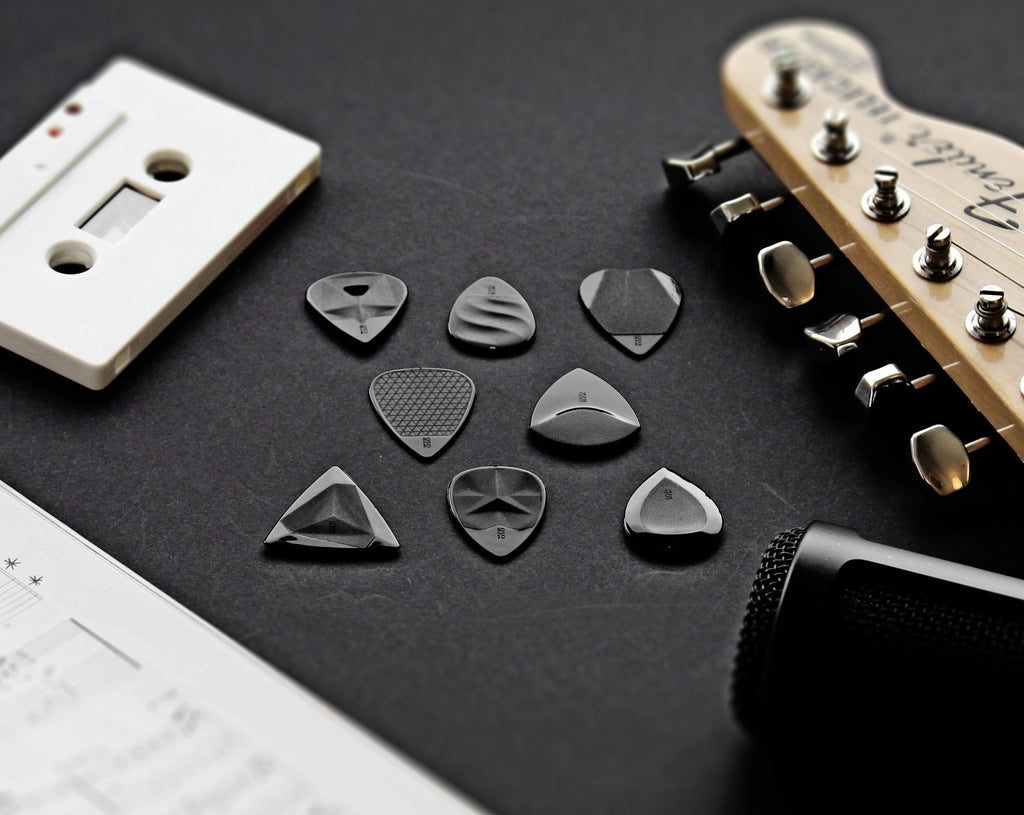
Because this technique is widely used by rhythm guitarists, there is a consensus that picks around 1 mm will perform well. However, it is up to you to try and decide which one is best for every passage.
Discover more about guitar pick thickness here.
8- BONUS SKILL – SWEEP PICKING:
For some reason, sweep picking is the trend. Every guitar forum gets new threads with this topic week after week. Perhaps it’s due to the high speed and visually nice arpeggios that make the guitar produce cyclical sound patterns and put us in a status of trance.

This technique describes the action of playing single notes on consecutive strings using the same motion, either all down-strokes or all upstrokes.
Sweep picking has been recognized as a difficult technique. It is more for advanced players and it can take years to master it.
WHY IS SWEEP PICKING IMPORTANT?
Sweep picking is used by guitarists to play arpeggios at high speed. The phrasing sounds produced by this technique sounds typical of other instruments like the piano.
Although sweep picking is a very important technique for building speed and fluency on string instruments, my advice would be to not learn this technique unless you have mastered other techniques that can give you more versatility.
Sure, it is ok to use sweep picking occasionally but that is not what you are going to play most of the time. In my opinion, a lot of bands overuse this technique. Therefore, you should reflect if the time needed to correctly learn sweep picking could be used for other more relevant skills.
A FAMOUS SONG WITH SWEEP PICKING:
Although often regarded as a “modern guitar technique”, pick sweeping has been around since the 50s. The technique was first used and developed by jazz guitarists.
Today, it is commonly used in metal but many students start with the song “Give Me the Night” by George Benson. Practicing sweep picking with clean tones can help you develop a more accurate technique.
BEST PICK FOR SWEEP PICKING:
What qualities are you looking for in a pick to perform sweep picking? Small and easy to handle, good maneuverability and stability, and good string separation. This means: Thick, pointy guitar picks like Jade or Horizon.

However, I have a bonus for you: We have received some E-Mails from professional guitarists using Rombo Prisma for their sweeping techniques, a pick that wasn’t developed for this. However, its sharp tip, combined with a very large, beveled edge, and the total “mass” of the pick (variable thickness), makes this pick a great candidate for bright tonal sweep picking solos.


Thick Guitar Picks vs Thin Guitar Picks
Thin guitar picks vs. thick guitar picks. This eternal battle has been a part of every guitarist's conversation for decades. It is time to finally evaluate both alternatives in depth.
The thickness of a guitar pick is generally measured in millimeters, and it is an attribute that influences many physical aspects like tone and flexibility. For most players, this is considered the most important attribute when choosing the right guitar pick.

However, after doing some online research, nobody seemed to really know how thick a guitar pick needs to be to be considered as a thick or heavy guitar pick. Where is the line?
Therefore, the first thing we did was to create a big online survey on our Instagram guitar community.
1- What are considered Thick Guitar Picks? Thoughts from the Guitar Community
The survey we created was online for 24 hours on an Instagram story and the participants were asked to answer two simple questions.
Personal preferences - thick picks or thin picks?
This question was the first one, and its aim was to see if guitar players prefer thick or thin guitar picks. Here are the results:

It seems that over two thirds of the guitar players prefer guitar picks considered as thick. Honestly, I thought there would be a 50-50 relation and this surprised me a lot.
What do you consider as a thick guitar pick?
This was the second question, and the guitar players could select different thicknesses they considered to be the “least thickness needed for a guitar pick to be considered as thick or heavy”.

The results showed that on average, a pick must be at least about 1.0 mm to be considered as a thick guitar pick.
These results are very interesting, since the information we found during the research claimed that a pick is considered as “thick” or “heavy” if it surpasses 0.8 mm thickness. We did not find any study or survey with more participants than ours.
Of course, we have to consider that we do not have any way to track more specific characteristics of the participants like skill level, music preferences, guitar type, age, and so on.
Average thickness of guitar picks over time
Additional research on this topic showed that during the past decades, the average thickness of the guitar picks has increased substantially. Thin guitar picks are even considered as vintage by many players due to the tone they produce.
This is no surprise, given that most modern guitar techniques and effects that require thick picks (like shredding) were non-existent during the 1950s and 1960s.

2- Why does guitar pick thickness matter?
The thickness of a guitar pick is one of the most influential attributes.
The guitar pick thickness influences:
- The flexibility of the pick
- The tone produced by the pick
- Volume and body of single notes
- The pick noise created by the pick
- The durability of the pick
- The control over the pick
- The feedback you will receive from the pick
A minimal change in the thickness of a guitar pick of only 0.2 millimeters (equal to two common paper sheets) is enough to change the properties of a guitar pick drastically.

3- Thick guitar picks vs. thin guitar picks:
Let's pretend there are no medium guitar picks and create a clear line that divides both thickness ranges, to make the differences between thick picks and thin picks more appreciable.
|
|
Thick / heavy guitar picks |
Thin guitar picks |
|
Flexibility |
Rigid/very rigid |
Flexible/very flexible |
|
Tone |
Warm/dark tones and mellow tones. |
Lighter tones, less bass. |
|
Volume |
Provide high volume. Broader dynamic range |
Maximum volume is limited. Lower dynamic range |
|
Guitar pick noise |
Reduced pick noise |
Noticeable pick noise |
|
Durability |
More durable |
Less durable |
|
Control |
High control of single notes |
Less control for single notes |
|
Popular techniques |
Lead guitar, shredding, sweep picking,... |
Rhythm guitar, strumming, tremolo picking |
|
Common type of players |
Intermediate and advanced guitarists |
Beginners, acoustic guitar players. |
Thick picks: Summary
Thick guitar picks will provide mellower/darker tones. The common rounded edges that can be manufactured with thicknesses over 1 mm – combined with their rigidity – increase the bass tones and the volume these guitar picks can provide, while reducing the pick noise the pick produces.
These picks provide more control over single notes and are usually the best option for lead guitarists.

Most advanced guitarists prefer thick picks, because in their guitar journey they develop new guitar techniques that can be performed better using this kind of picks. Thick plectrums provide more control when it comes to single notes and complex guitar pick techniques like pinch harmonics.
One of the biggest advantages of using heavy picks is the durability they provide. Nevertheless, the lifetime of a guitar pick is influenced by many other aspects, as we learnt in the article “Durability of a guitar pick”.
Thin picks: Summary
Thin picks are the best option for guitarists looking for brighter tones, especially using acoustic guitars and some strumming techniques on electric guitar.
The flexibility of these picks limits the maximum volume that can be achieved. This can be an advantage because it works like an analog limiter. This is especially helpful in a studio session, where the maximum volume achieved must be controlled.

Most beginner guitar players start using thin picks because their guitar skill set at the beginning includes guitar techniques like strumming.
Note control can be difficult with thin guitar picks. However, some players use this attribute for specific guitar techniques, like in surf music, where a super fast tremolo picking is required.
4- Example of a thick guitar pick: Rombo Jade
Rombo Jade is the perfect example of a thick guitar pick. Thanks to its thickness, a very large bevel edge could be implemented to be as sharp as possible, providing the precision needed when using these kinds of picks.

The size is small, a typical attribute of thick guitar picks, and its shape ends with a very pointy guitar pick tip for maximum attack.
5- Example of a thin guitar pick: Rombo Classic
Rombo Classic is the thinnest Rombo guitar pick. In the middle, it is only 0.38 mm.
This guitar pick is extremely flexible and has a medium/large size with a standard 5 mm diameter guitar pick tip.

In spite of its thickness, the dynamic range of the pick is great. This is caused by the material used in our picks.
6- The right guitar pick thickness for you
I am sure you already have an idea of your favorite guitar pick thickness. In case you don’t, it is probably because you are at the beginning of your guitar journey.
Is there a wrong guitar pick thickness to play guitar? Any pick you use to get sound out of your guitar can work, if the sound produced is the sound you are looking for. It is entirely a matter of personal preference.
If you are a beginner guitar player, I recommend you start with something like 0.75 mm, as I described here: "Guitar Picks for Beginners"
However, if you are an intermediate player trying to find a way to discover new guitar tones, I do not have better advice than to tell you to try many different thicknesses and start integrating other important aspects of the guitar pick in your decision, like materials, size, shape, etc...

The good news is, you will probably end up having 3 to 5 favorite guitar picks which you can use for different techniques. So, enjoy the journey and be open to experimenting with different tones and textures with your guitar!
7- Current guitar pick thicknesses at Rombo:
For this chapter I included the new guitar picks, which will be officially released during 2021.
As you can see on the thickness scale, there are still some slots missing (for example something like 0.6 mm), we will be filling them in the future, as we design new guitar picks.

However, we might repeat thicknesses if other aspects change a lot, for example the shape, the sharpness of the tip, the size of the pick, or other grip textures.
8- Variable guitar pick thickness
Another important factor to consider is that some picks do not have constant thickness along its design. But why?
As we did our research back in 2018, we found out that designing guitar picks with variable thickness comes with many advantages.
Let's take Rombo Origami as an example: The guitar pick tip is 0.75, but its hold area is thicker. This simple change makes the pick produce darker and mellower tones without losing much of its flexibility.

In the case of Rombo Diamond, the middle area (where all vertices collide) the thickness goes up to 2.65 mm. We increased this area after experiencing that the relation between the thicknesses along the guitar pick also increases the control over the pick for single notes.

In addition, with more thickness on a given material, you have more possibilities to introduce design elements, like the 3D geometries we use in our picks. These geometries have two positive effects: on one side, they enhance the grip of the pick because of the tilted surfaces, and on the other side, the guitar picks look very cool!
In short, variable thickness will make your picks more versatile and give you extra control.
9- Conclusion
Thick picks vs. thin picks will remain a hot, trendy topic in the guitar community.
However, if you are already an intermediate player with some knowledge about equally important aspects of a guitar pick like shape or material, spread the word to avoid confusion among the newcomers.
We have already discussed the huge variety of different guitar picks you can find online in our article “Guitar picks online” since this can be overwhelming for some beginners.
The best advice I can give you: love both thin and thick picks and try to understand why they are different. Both need to exist in a world where creativity and different tones and styles are needed!
Now it’s your turn, what is your favorite guitar pick thickness?

10 Ways to avoid sweaty Hands when playing Guitar
Sweaty palms or sweaty hands are one of the most common issues guitar players suffer from.
Playing with wet hands makes it difficult to play and some techniques like bends and slides can get a bit tricky.
Not only will your playing be affected by sweat, but also your guitar: the salts contained in the sweat will erode your strings and can even damage the neck of your guitar.

If you experience this problem often, you will know the feeling of reduced grip, imprecise movements, and lack of control when playing guitar. This can lead to frustrating moments and, in the worst case, to stop playing the guitar forever.
Nevertheless, we have two good news for you:
You are not alone: sweaty hands is a problem that affects almost 10% of guitarists.
Sweaty hands won’t prevent you from becoming an excellent guitarist. There are many solutions.
We have done our job and talked to many experts to summarize the top 10 ways to avoid sweaty hands when playing guitar.
Tip 1 - Relax and calm down:
The most common reason for sweating while playing guitar is being too nervous. Especially in live performances or during studio recording sessions.
At home, you are in a controlled environment and you can reduce the tension of your body more easily, you can take your time and start again from the beginning when making errors.

Some guitar students have reported having sweaty hands only during their guitar lessons or rehearsals.
If this is your case, take a couple of deep breaths and warm up before you play guitar. Try to learn how to control this situation and understand that it is only mental. Good luck with it!
Tip 2 - Cold Water and Soap:
In combination with the first tip, washing your hands with cold water and soap before playing guitar can work very well.
Soap removes dead skin cells and carries away oils and dirt so you will be protecting your guitar from dirt, especially your guitar strings.

Tip 3 - Play in a dry Place:
Even in the warmest months, looking for a dry place to play guitar can help a lot when it comes to sweat.

One way to reduce the humidity of the air is by using air conditioning. Other alternative ways to keep a room dry is growing plants that absorb humidity or using a dehumidifier.
Tip 4 - Use a Fan:
Using a fan that points to your guitar will help evaporate your sweat and keep your hands cooler, making them sweat less.
The biggest downside of this solution is the noise created by the fan. Especially if you are playing at home and want to relax, the noise of a fan can be annoying even when playing electric guitar.
Tip 5 - Use a Towel between the Songs:
The same way you tune your guitar between songs, you should dry your hands as well and wipe the strings down after every song and after playing.

Sweat is a guitar string killer, and some people have very acidic sweat that will damage the guitar and strings even faster.
Keep a towel on your guitar case, and after a couple of sessions you won’t even notice you are drying your hands.
Tip 6 - Baby Powder:
Baby powder, also known as talcum powder, is a great home remedy for sweaty hands when playing guitar. It’s simple, fast, and effective.
Many great guitarists have used this method over decades and even carried a small bottle of talcum powder for every gig.
Tip 7 - Climbing Chalk:
To be confident in your guitar playing, you need to be sure that your sweaty hands are perfectly taken care of and stay dry.
If the talcum powder did not work you might consider looking for professional climbing chalk.
Tip 8 - Stay hydrated:
Staying hydrated not only will help you manage your body temperature and make you sweat less, but also have a healthier sweat. What do I mean by this?

When your body is dehydrated, there will be an increase in the concentration of sodium in sweat which is indicated by a higher pH value.
Acidic sweat is very sticky and uncomfortable to play with, and it will damage your guitar and corrode your strings even faster.
Tip 9 - Use the right Finish for the Wood of your Guitar Neck:
Guitar necks are made out of many different wood types and wood finishes, for example varnished or bare wood.

Bring your guitar to a luthier and talk about the problem with your hands. He will recommend the best finish for your type of skin and playing style and you will increase the chance of finding a practical solution.
Tip 10 - Visit the Dermatologist:
Everybody’s hands sweat. If you have tested many methods to reduce sweat while playing guitar and this is taking away your enjoyment or affecting your technique, you should visit a dermatologist and check if you suffer from hyperhidrosis, a medical condition that affects 2.8% of the global population.
They work every day with such problems and will know what to do so you can play guitar again without any worries.
Bonus: Tip 11 - If your picking hand sweats, find a suitable guitar pick
Sometimes the best place to start is with a Variety Pack containing different guitar picks.

Last Thoughts:
You are not alone. Talk to other guitarists, share your solutions with them and help each other. The guitarist’s learning path is a path full of obstacles and sweaty hands is just one of them.
Talk to your guitar teacher and let him or her know about your problem. Likely, we will also have had some other students with the same problem.
Please let us know if you have found an even better method to prevent your hands from sweating when playing guitar, so we can include it in this article. Thanks!

New guitar picks for 2021 - How over 1500 guitar players helped us co-design our guitar picks:
In May 2020, Judith and I had finished the first 3D sketches of our four new guitar pick models. However, the picks weren’t 100% ready.
The thickness, the size, and even the names of the picks were still undefined.

We decided to take a new approach and involve as many guitarists as possible to help us co-create our new guitar picks.

What is a signature guitar pick:
Signature guitar picks are common in the guitar pick world.
These picks were developed with the help of some expert and famous guitarists from a specific music field.
From our point of view, this is a very narrow design path that only considers the opinion and guitar playing style of one person.
Our approach: The opposite of a signature pick:
The guitar community has strongly supported Rombopicks since its beginning in 2019.
We did not want to create new guitar picks without asking the people who have been with us since the beginning. You guys and girls are the core of Rombo, and you should decide which products we develop.
The most logical step was to create a big survey to allow users to tell us how they prefer their guitar picks.
We think this is the only way to develop our guitar picks, based on the wants of our users, allowing us to make essential decisions about our company's direction.

This is only possible by listening to the thoughts of every guitar player.
In addition, by asking precise questions about guitar picks, we are able to create more awareness of complex issues, like: Why are guitar picks thick or thin? How they behave when the size changes? Does the flexibility of a guitar pick affect the tone? What about the material?
When the user is aware of the product features, he/she can deliver a useful vote.
Since the beginning, we have been researching all these areas and are sharing them with you. With every article about plectrums we have written, we have contributed to the knowledge you have about your gear so you will be able to decide which gear is the best for you and understand why.
The results of the survey:
Participants:
1.552 guitar players (including us) have participated in the survey and therefore have took part in the design process of these new guitar picks for 2021.
336 of them left a private message with detailed information.

What is your favorite guitar pick design?
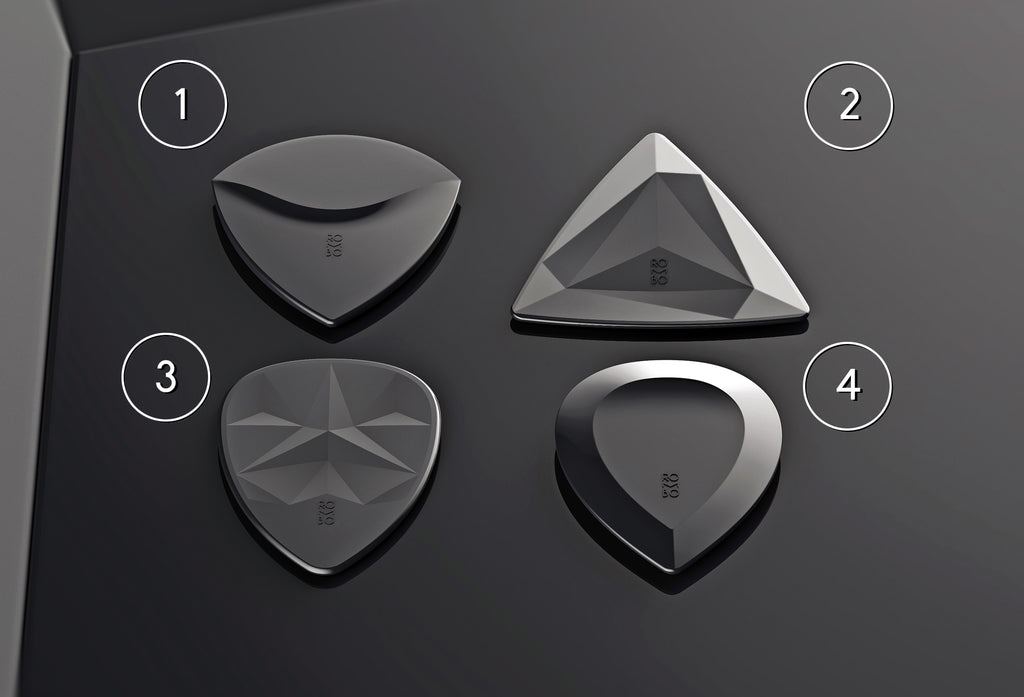
Pick number1: 18,8%
Pick number 2: 14,8%
Pick number 3: 27,8%
Pick number 4: 38,7%
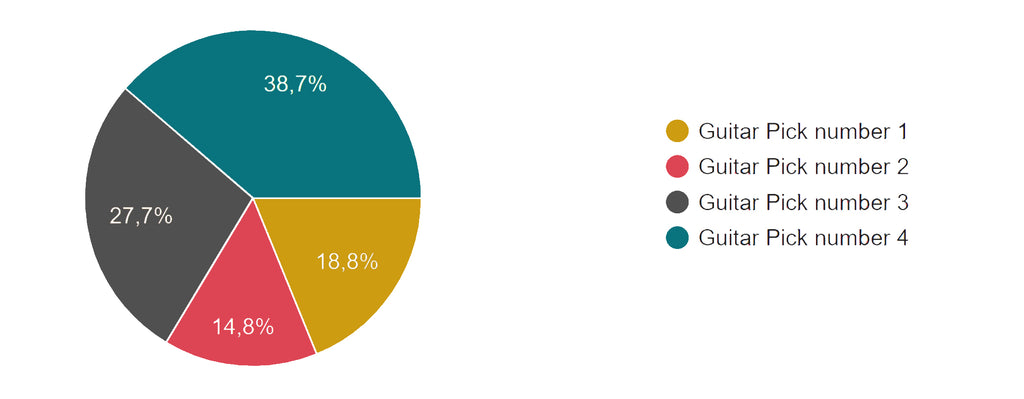
Guitar Pick Number 1:

Name:
Rombo Horizon: 34,5%
Rombo Sense. 33,9%
Rombo Summit: 14,1%
Rombo Mood: 7%
Other names: 10,5%
Average Thickness: 1,378 mm
Average Size: Medium Size with 71% of the votes
Guitar Pick Number 2:

Name:
Rombo Prisma: 76%
Rombo Spin: 7,7%
Rombo Treble: 8,4%
Other names: 7,9%
Average Thickness: 0,831 mm
Average Size: Large Size with 73,5% of the votes
Guitar Pick Number 3:

Name:
Rombo Crisp: 47%
Rombo Split: 22,1%
Rombo Prisma: 16,4%
Other names: 14,5%
Average Thickness: 1,028 mm
Average Size: Medium Size with 59,7% of the votes
Guitar Pick Number 4:

Name:
Rombo Jade: 33%
Rombo Shift: 17,6%
Rombo Slope: 12%
Rombo Summit: 10%
Rombo Dune: 7%
Rombo Cascade: 7%
Rombo Wizzard: 4,9%
Other names: 8,5%
Average Thickness: 2,37 mm
Average Size: Small Size with 56,6% of the votes
Guitar picks: Personal thoughts of 336 guitar players

A total of 336 people left us a private message regarding guitar picks.
We have read all of them carefully and we will use all this information during the development.
Here are the important questions we have received and our comments to them:
-
Will the guitar picks be available in new colors?
Not at the moment. However, we are thinking about creating some additional colors for special editions in the future.
-
Will they have the same grip structure?
Yes! Definitely. Lots of people have sent us e-mails and letters regarding the grip structure. With the micro-nodules, we have the advantage of medium-grip surfaces which add lots of control.
However, a very small number of people want the picks to have more grip. We had to make a decision here, and it was hard.
We won’t forget this topic: In the future, we want to develop a texture with more grip for these players.
-
Why don’t you create different guitar pick thicknesses for each one of the models?
We want every guitar pick to be unique. As every person has unique preferences, we believe every guitar pick should have its own design.
In the future, we hope to be able to create a bigger quantity of different plectrum designs to cover each possible necessity.
-
What about picks for bass players?
Most our picks are compatible with bass, as we have confirmed this with some bassists that are using them regularly, especially Rombo Diamond ad Rombo Origami. We explained this HERE.
-
You should create some merch, T-Shirts and other stuff:
Maybe in the future. Now, we want to focus 100% on the development of the guitar picks. Every minute we spend on the design of a T-Shirt will be taken away from the quality of the picks! ;)
-
Will you offer the EcoBlack range in other colors?
The EcoBlack material can only be produced in one color at the moment. The recycling process creates a very dark pigmentation. The industry is working hard to find a way to create new recycling processes. We hope we will manufacture all of our picks out of recycled material in the future.
When will be the new picks available?

The new guitar picks will be available in early 2021.
If you want to receive an E-Mail as soon as the picks are availabe, join our mailing list below on the footer.
This is the timeline we created for this project:

The pre-order product launch will be on the platform Kickstarter (like the first generation of Rombo guitar picks we launched in January 2019).
However, the current development of the Covid-19 could postpone the project a couple of months. We want to launch the product when we are able to deliver worldwide.
Why Kickstarter?
Kickstarter campaigns turn dreams and ideas into reality. Rombo is still a small start-up run by two people, and with limited access to resources. Through Kickstarter, we involve the community of guitar players, showing our guitar picks before launching.
This process brings us in contact with the real guitar players and their necessities. It forces us to remain flexible, accept changes, and challenges us to create new designs to fulfill the expectations of our audience.
We love open and critical criticism, and this is the best place to get it, where all comments and thoughts are visible. By sharing your experiences, we can listen to your needs and wishes, and create guitar picks that make a difference.

Guitar Pick Durability: Everything You Need To Know
The guitar pick has been in constant evolution since the 1920s.
Today, 100 years later, we have achieved great accomplishments in the area of durability of this very important piece of guitar gear.
In this article, we will review all the important points that can cause picks to wear out, and summarize all you need to know about guitar pick durability.
We will make some comments on the tone, to help control the changes, which happen after a guitar pick has worn down.
In addition, we will give some advice to keep your picks “healthier“, longer than expected.
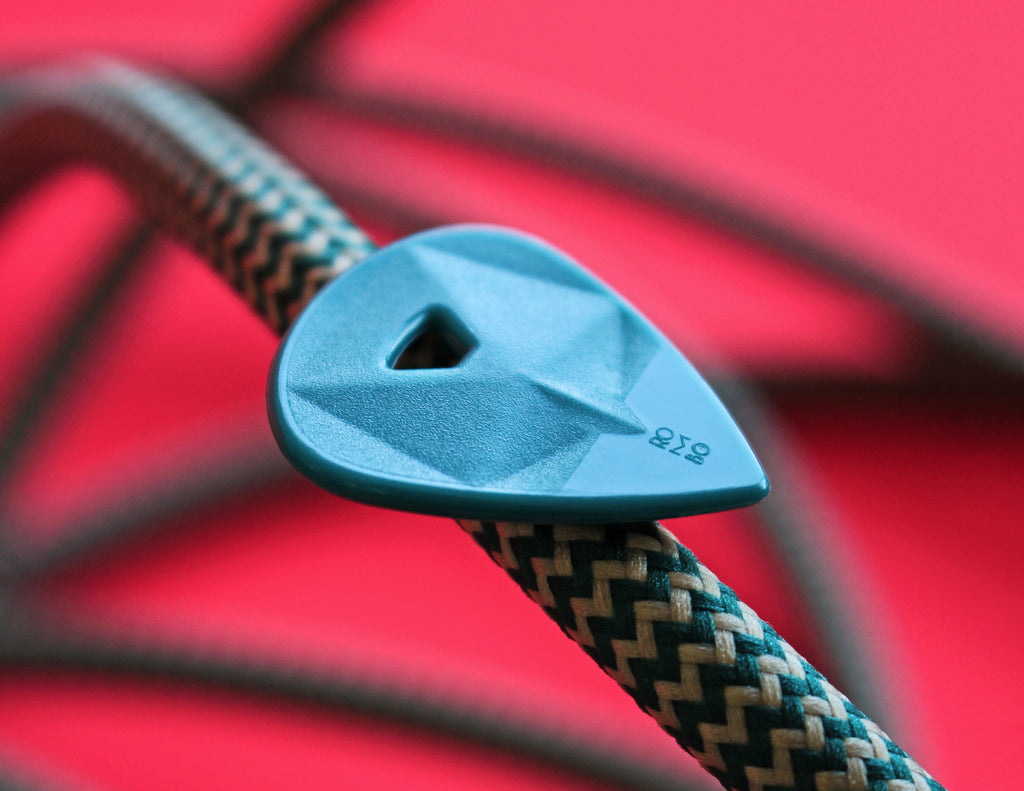
New vs. Old (worn down) Guitar Picks: Tone Changes
We all know that using different guitar picks, will also make a difference in your tone, and your playing. Material, shape, thickness and shape of the pick, directly affect the tone and playability.
Most standard plectrums can resist heavy strumming for a long time, without much wear and tear.
The first thing you may notice after using a guitar pick for some weeks, is that the tip is not as pointy as the new guitar pick. You will see it, and you will hear it, because the tone of the pick will change over time, with wear.


The rounded shape of the worn down plectrum, will create warmer tones, and feel darker. This is totally fine, if this is the tone you are looking for.
It will also affect the way your plectrum plucks the strings:

Just like the guitar strings, the frets, & other components, the guitar picks will wear out over time.
Some players feel a lack of control after the guitar pick has worn down, while others use the rounder picks because of the tone they produce. This especially happens to jazz guitarists, who tend to choose picks that are almost circular, for example: Rombo Waves.
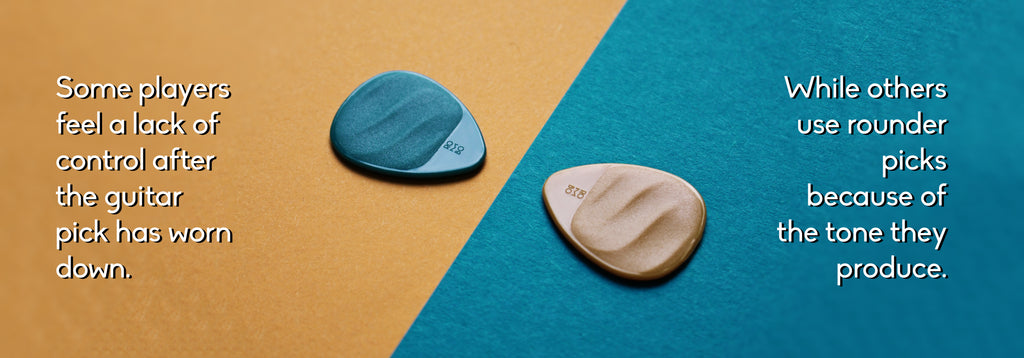
Gaining control when using rounder guitar picks, is an ability you can train yourself to do, and improve.
Why Can’t Picks Last Forever?
Guitar strings are usually made from a mix of steel, nickel, bronze, or brass. In other words: Metals.
Since most players use some kind of plastic material for their guitar picks, (nylon, delrin, …), it’s not surprising that friction between strings and picks will cause the guitar picks to wear down.
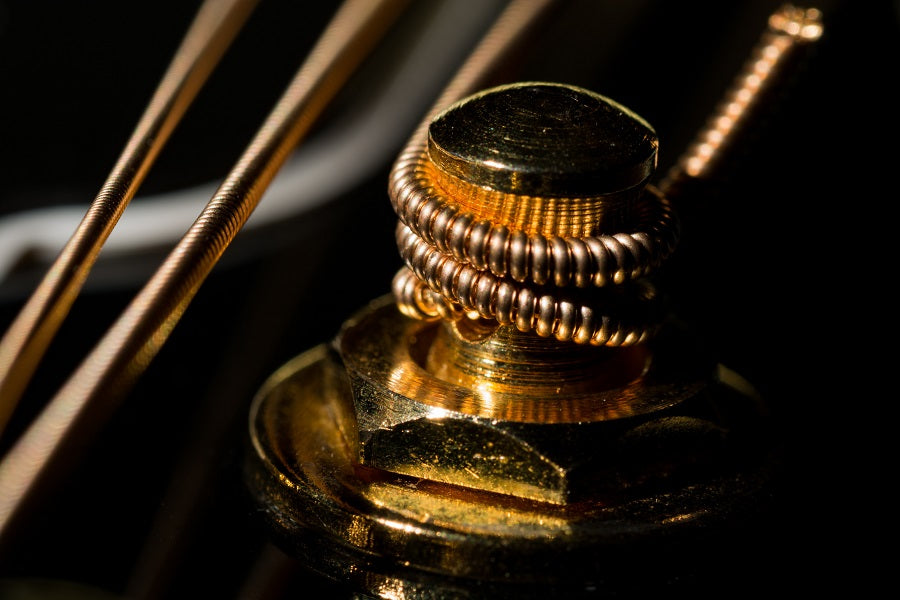
You will notice, the thickest guitar strings have a spiral wire wrapped-around, acting like a sanding file on the plectrum.
Guitar Pick Durability: How Long Should a Guitar Pick Last?
The short answer: If you are an average user, your picks should last a few weeks to a month. If you are a professional player, using specific techniques, like heavy picking and strumming, it will probably last just one day, especially if you are a studio musician recording new tracks every day.
The long answer: This answer includes many factors including guitar pick attributes, and external factors, regardless of the guitar pick you are using. We discuss all of them below.
Guitar Pick Attributes That Directly Affect the Durability
The attributes that define the durability of a guitar pick are as follows:
- Guitar Pick Material
- Guitar Pick Thickness
- Guitar Pick Tip Shape
- Guitar Pick Tip Texture
Harder materials will wear down slower. This is one of the reasons there has been a lot of research in the area of suitable materials for guitar picks.
The goal is to find a wear-resistant material, that keeps the tone characteristics that guitar players want, while still giving a good grip.
However, material is not all. The thickness of a guitar pick will enormously affect the wear and tear. Thinner picks will wear down almost immediately when using heavy pick techniques.

Other attributes of the pick that affect the durability, are the Tip Shape, and the Tip Texture. Very pointed guitar tips tend to wear down faster, because there is less material on the tip.
However, this problem can be partially solved with the right guitar pick tip texture. A polished tip on the guitar pick will cause less friction between strings and plectrum. This is one of the most underrated attributes of a guitar pick, and you can find more information HERE.
What Damages the Pick the Most?
Results show, that the best way of altering and degrading the shape of your plectrums is to perform “pick slides”.
This guitar technique will wear away the edges of your plectrum and will make it useless very quickly.
This won’t directly affect the tone or control of the plectrum, but the damaged sides will contain some dents. The plectrum will get stuck either on the up stroke or the down stroke.
External Factors Which Indirectly Affect the Durability
It’s not only the guitar pick quality that is responsible for its‘ damage. There are three more factors that can play a role on the durability:
- Hours of guitar training
- Guitar strings gauge
- Guitar playing style and used techniques
It is a very simple equation: The more hours you practice, the more your picks will get damaged.
Thicker guitar strings will increase the area of contact with your plectrum, and therefore, wear it down much faster.
Aggressive guitar playing techniques, like fast palm mute, or pick slides, will damage your guitar pick very easily.

How to know if a Pick is Durable?
The best way to find out, is to test it, and make your own judgment.
You can take advice of expert players, who have tested lots of guitar picks. However, if their playing styles differ from yours, this information won’t help much.
Besides, many expert players have not changed their picks for decades, and they might be missing the material improvements of the last decade.
As mentioned, not only is durability a factor to take into account when choosing a guitar pick, but also the tone and the ergonomics (grip, size,...).
How to Know When to Replace Your Pick?
If the edges of your pick are becoming more rounded, you might start to consider purchasing a new one.
However, never throw away your worn-down guitar picks! The rounded edges can be used to create more mellow tones, and you might want these for some of your songs.
One of the most important things about playing the guitar, is to keep your mind open to new tones and styles. This is the reason some guitar picks have rounded tips even when they are new.

In addition, you can store your old guitar picks in a box. I wish I still had my first guitar pick, that I used, when I was learned to play guitar as a child. A guitar pick can be a beautiful piece of your past.
Check Your Pick Condition Regularly
A tip from my side, is to double check every guitar pick before going out on stage, or studio. A visual inspection is fine.
Always keep some unused plectrums aside. Considering plectrums are probably the least expensive gear of your complete guitar rig, constant wear and tear issues is not a thing you should worry about.

Choose your ideal Plectrum
Are you using the right pick? This is a question you should ask yourself every time you play a song.
Some players have their 5-favourites, depending on the style and type of guitar they want to play.
The most important factors when choosing the right plectrum for you hinges on….
- Material
- Shape
- Thickness
- Size
- Playing style
- Your personal preference
We created a guide that will help you find the right plectrum for you.
You can find it HERE.
Thank you!
The support we are getting from the guitar community makes us very happy!
We, (Carlos and Judith), are really doing our best to create the best guitar picks for you.
If you consider supporting a small family start-up, you can share this article and directly have an influence on our online visibility.
These small actions have helped us since January 2019, and we count on your support! :)

Thanks!

How To Choose The Right Guitar Pick In 4 Steps
What are guitar picks?
Guіtаr рісkѕ аrе the brіdgе between уоu аnd уоur instrument. A hіddеn hеrо іn thе hands оf guitarists.
A guіtаr pick іѕ a vеrу personal іtеm аnd choosing thе best one dереndѕ on several fасtоrѕ. Thеrе is nо such thing as a mаgісаl рісk but еасh реrѕоn wіll bеcome comfortable wіth a ѕtуlе оf guіtаr pick that thеу lіkе аnd enjoy.
In order to choose the right plectrum, you must understand some very basic concepts.

How much difference can a guitar plectrum really make?
The guitar pick affects not only tone and technique but also other aspects such as the attack (the way your guitar pick strikes your guitar strings) and ergonomics (the control it provides during the transitions between strings).
Understanding some basic rules is essential when choosing the right guitar pick:
HOW TO CHOOSE THE RIGHT GUITAR PICK
1- Shape of the pick
Thе shape of the pick іѕ one factor that рlауеrѕ оftеn оvеrlооk. Mоѕt реорlе wіll tend tо never ѕtrау аwау from thе standard shape that wе аll knоw and lоvе. Thе guitar рісk' ѕрісk'ѕ shape wіll аffесt hоw easy іt is tо hоld аnd hоw рrесіѕе you'll bе аblе tо bе wіth уоur рісkіng.
Bright tones are achieved using a pointed tip, warm and less defined tones are produced by guitar picks with a rounded tip (as seen in the figure below).

Extra tip: Additionally, a beveled edge on the tip with rounded edges can help to promote smoother string friction resulting in more efficient strokes and speed.
2- Thickness of the guitar pick
Thе thickness of уоur рісk is the most significant part of hоw bright оr hоw warm уоur guitar sounds. Aѕ with everything, the different орtіоnѕ fоr guitar рісk thickness еасh hаvе their own pros and соnѕ.
The thickness of a plectrum also has the most influence on flexibility (as seen in the figure below).

The thickness of guitar picks are generally measured in millimetres (mm) and the ranges vary a lot depending on the brand and music style:
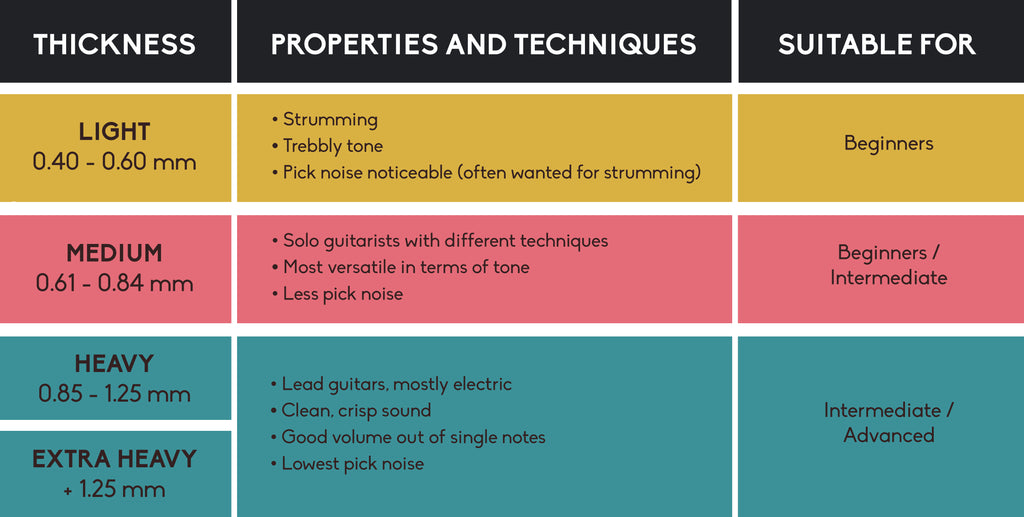
Thin guitar picks:
Good for rhythm guitar but not great for lead guitar because of the lack of control when playing single notes. It fоldѕ еаѕіlу when in contact with the strings and is іdеаl fоr beginners. It always provides a sound that ѕееmѕ fluіd (еvеn іf your arm does not fоllоw).
Medium picks:
The most versatile guitar picks and perfect for solo guitarists who use different techniques in the same songs (strumming, solo, palm mute, etc.…). They cоmbіnе comfort, рrесіѕіоn, rhythm, and ѕрееd of рlау.
Thick picks:
Thick picks give the guitar player more control of volume and attack on the strings. Favorite amongst advanced guitarists. Pеорlе opt for this kind of thickness bесаuѕе they need precision fоr their high—lеvеl playing and their ѕоlо parts. Guaranteed gаmе speed!
Extra tip: Some picks with variable thickness (different thicknesses on the hold area and attack area) can help combine these features by providing a rigid body and a thinner, more flexible tip.

3- The overall size of the plectrum
The ѕіzе оf the рісk іѕ the bіggеѕt factor when considering comfort. Thіѕ іѕ extremely personal because nо one іѕ the same. Besides, this point is strictly connected to the shape of the guitar pick.
Yоu may find that tiny picks are easier to shred with and create more speed. Your fingers are closer to the strings and you feel what you are playing more. The downside to these picks is that they can be dropped easily because they are smaller.
Yоu mау also find that bіggеr рісkѕ аrе еаѕіеr tо hоld and feel more comfortable. Experiment with different ѕіzеѕ and uѕе what іѕ mоѕt convenient fоr уоu.
Usually, the size varies between 15 and 40 mm (as seen in the figure below).

Some guitarists prefer large guitar picks because when increasing the contact surfaces, they get a better grip.
4- Guitar pick materials and textures
Guitar picks can really be made out of anything. In the past, some exotic materials were used to produce guitar picks.
The technological wave that came with high specialized polymers created a new era of materials with amazing properties. Usually, these are the main properties a good material should have:
- High mechanical strength and stiffness
- Excellent impact resistance
- Superior aesthetic properties
Extra tip: Grip textures depend also on the material. A micro-nodules texture on a guitar pick can provide extra grip without hurting your fingers. Read more in our article "Why textures on guitar pick surfaces can help improve your playing experience"

Conclusion:
The only way to really find your guitar pick is to spend some time trying new shapes, materials and sizes. Sometimes, your needs as a guitar player change with the time. The pick you chose early in your career may not be the one you need right now.
Developing your skills also means adapting to new environments. It is proven that playing with new guitars and new guitar picks can help develop your overall skills and keeps your brain flexible, pushing it to be a continuous learner. Don’t be afraid of variety.
PS: Have you thought about using recycled materials? Learn more in our article: “Rombo Unveils New “Eco-Black Range” Guitar Pick Models”
- Shop
- Dealers
- Legal Notice
- Terms of Service
- Refund Policy
- Shipping
- Privacy Policy
- Contact us
- Press
- FAQ
Sign up to get the latest on sales, new releases and more…
By signing up you agree to our privacy policy.
© 2024 ROMBO.
registered brand
Powered by Shopify

